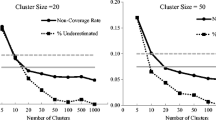Abstract
Repeated measures, or longitudinal data, are considered. The statistical characteristics for each individual case are supposed to be governed by a structural parameter, common to all, and an incidental parameter, specific to the individual. Introducing this terminology, Neyman and Scott studied the properties of estimators in a likelihood framework. In this paper the model specification is taken to be more limited, not sufficient to construct a proper likelihood function. The proposal here is to seek an estimating function, based on the data and the structural parameter alone, whose maximum has an identifiable limit as the sample size grows. Then a transformation of the maximum is sought so that the modified version is a consistent estimator. Some examples are worked through and asymptotic distributions of the resulting consistent estimators are outlined to enable tests and confidence regions to be derived. Relative efficiency of competing estimators is also considered.
Similar content being viewed by others
References
Andersen E.B. (1967) On partial sufficiency and partial ancillarity. Skandinavian Aktuarial Journal 50: 137–152
Andersen E.B. (1973) Conditional inference and models for measurement. Mentalhygienisk Forlag, Copenhagen
Barndorff-Nielsen O.E. (1983) On a formula for the distribution of the maximum likelihood estimator. Biometrika 70: 343–365
Barndorff-Nielsen O.E., Cox D.R. (1994) Inference and asymptotics. Chapman and Hall, London
Berger J.O., Liseo B., Wolpert R.L. (1999) Integrated likelihood methods for eliminating nuisance parameters. Statistical Science 14: 1–28
Boos D.D. (1980) A new method for constructing approximate confidence intervals from M estimates. Journal of the American Statistical Association 75: 142–145
Breslow N. (1981) Odds ratio estimators when the data are sparse. Biometrika 68: 73–84
Cox D.R. (1993) Unbiased estimating equations derived from statistics that are functions of a parameter. Biometrika 80: 905–909
Cox D.R., Reid N. (1987) Parameter orthogonality and approximate conditional inference (with discussion). Journal of the Royal Statistical Society B 49: 1–39
Crowder M.J. (1986) On consistency and inconsistency of estimating equations. Econometric Theory 3: 305–330
Crowder M.J., Hand D.J. (1990) Analysis of repeated measures. Chapman and Hall, London
Doob J.L. (1953) Stochastic processes. Wiley, New York
Firth D. (1993) Bias reduction of maximum likelihood estimates. Biometrika 80: 27–38
Gesch C.B., Hammond S.M., Hampson S.E., Eves A., Crowder M.J. (2002) Influence of supplementary vitamins, minerals and essential fatty acids on the antisocial behaviour of young adult prisoners. British Journal of Psychiatry 181: 22–28
Hand D.J., Crowder M.J. (1996) Practical longitudinal data analysis. Chapman and Hall, London
Kalbfleisch J.D., Sprott D.A. (1970) Application of likelihood methods to models involving large numbers of parameters (with discussion). Journal of the Royal Statistical Society B 32: 175–208
Kiefer J., Wolfowitz J. (1956) Consistency of the maximum likelihood estimator in the presence of infinitely many incidental parameters. Annals of Mathematical Statistics 27: 887–906
Lancaster T. (2000) The incidental parameter problem since 1948. Journal of Econometrics 95: 391–413
Liang K.-Y., Zeger S.L. (1995) Inference based on estimating functions in the presence of nuisance parameters (with discussion). Statistical Science 10: 158–199
Loeve M. (1963) Probability theory. Van Nostrand Reinhold, New York
Morton R. (1981) Efficiency of estimating equations and the use of pivots. Biometrika 68: 227–233
Neyman J., Scott E.L. (1948) Consistent estimates based on partially consistent observations. Econometrica 16: 1–32
Portnoy S. (1988) Asymptotic behaviour of likelihood methods for exponential families when the number of parameters tends to infinity. Annals of Statistics 16: 356–366
Reid N. (1995) The roles of conditioning in inference (with discussion). Statistical Science 10: 138–199
Wald A. (1949) Note on the consistency of the maximum likelihood estimate. Annals of Mathematical Statistics 20: 595–601
Author information
Authors and Affiliations
Corresponding author
About this article
Cite this article
Crowder, M. Estimating functions for repeated measures with incidental parameters. Ann Inst Stat Math 63, 535–558 (2011). https://doi.org/10.1007/s10463-009-0243-3
Received:
Revised:
Published:
Issue Date:
DOI: https://doi.org/10.1007/s10463-009-0243-3




